A Spectator's Guide to RC Pylon Racing
Pylon Races are not just for pilots, but are great events for spectators, too. There is a lot going on during a pylon race—and flying is only part of the activity. This article is written for the spectator and describes how a pylon event is organized and run at Sanderson Field, Shelton, WA.
The Race Course
The race course is defined by three pylons which form a triangle. The distance from pylon-1, at the apex of the course, to pylon-2 and pylon-3 is 608 feet; the base of the triangle, between pylons-2 and pylon-3 is 100 feet. The start/finish line is located inside the triangle and 508 feet from pylon-1. Ten laps around the course equals 2.5 miles. Pilots fly their aircraft around the course in a counterclockwise direction—left turns all the way. The course length is selected to result in 10-lap times between one minute (fast pace) and two minutes (slow pace for beginners). For the quickest aircraft, the speed around the course falls typically between 180-200mph.

Event organizers arrive at the flying field a day before the actual event to set up the race course. It takes several workers to set up the heavy pylons, each 20 feet high. Pylon-1 is positioned at one end of the course near a signal board.

The signal board contains a light for each lane to signal when a pilot's aircraft "breaks the gate." A pilot seeing this signal knows that he can make his turn at pylon-1 without "cutting." There are two other lights on the board for each lane that are used to indicate "cuts" (turns on the inside of a pylon). The lights are controlled by the flaggers through a wireless connection between the flaggers tent and the signal board (gone are the days of faulty cable connections).

As can be seen from the figure above, there were four lane designations: lower green (lane 1), lower red (lane 2), upper green (lane 3), and upper red (lane 4). Each pilot identified his/her aircraft with a press-apply decal corresponding to an assigned lane. More on this later in the article.
Race Officials
The Contest Director (CD) has the "absolute authority" during a pylon competition. The primary responsibility of the CD is to insure the safety of the event. At Sanderson Field, the CD conducts meetings for both the pilots and the course workers to insure that each person knows the basic rules. The CD also conducts the awards ceremony at the end of the competition.
On the race course, the starter acts for the CD. Unless overruled by the CD, the starter's actions and decisions on the race course are final. There will be more on the starter's responsibilities later in the spectator's guide.
Course Workers
Course workers are primarily volunteers. There are several "stations" around the course to which course workers are assigned. These included stations for cut judges (pylons 1-3), fueling station, flaggers, and timers/lap counters. If there are not enough course workers for every job, pilots and other event participants fill in where needed. The volunteers free the pilots to concentrate on readying their aircraft—and flying. If you are a spectator, you might be able to participate as one of the vounteers.
The Planes
The Regulations for pylon racing discuss everything from the spinner to the tail. Design specifications in the regulations for each class of competition include those for the wing, fuselage, power plant, landing gear, propeller, construction materials, and many other parts of the plane.
In the past, there have been three classes (called events by the AMA) that have been flown at Sanderson Field:
- 424 APRA: Sport Quickie,
- 428: Quickie 500 (Q-500),and
- 422: Quarter 40 (Q-40).
The Sport Quickie (424 APRA) is the entry level event and the planes are the slowest of the three, reaching about 110 mph around the course. Their specification insures that the cost for the plane and engine will be low. The planes are readily available commercially. Wings and tails must be constructed of either all wood or wood sheeting over a solid foam core. In the APRA 424 event, there is no motor RPM limit and the Thunder Tiger motor is used: all other rules are the same as for the AMA 424 event).
The Quickie 500 (428) is the next step to high performance RC pylon racing. The "500" refers to the minimum wing area for the class of 500 square inches. Unlike the Sport Quickie, wings and tails manufactured in molds designed to produce hollow core structures can be used. With the engines permitted for this class, the planes can reach speeds around 170mph.
The Quarter 40 (422) is the fastest of the classes. These are the planes that reach the 180-200mph top speeds. Q-40 planes are often all composite and "painted in the mold" resulting in beautiful, sleek—and fast—racers. As specified in the regulations, the planes in this class must also resemble real airplanes.
For the first time, a new class of pylon racer might very well be flying at Sanderson Field during the 2011 racing season. The new class is designated by the National Miniature Pylon Racing Association (NMPRA) as Electric Formula One (EF1). The new class will provide pilots with a relatively inexpensive—and quiet—entry into the excitement of pylon racing. The class will serve as a great "beginner's" plane for new pylon pilots—as well as being just plain fun to fly by experienced pylon pilots, too. EF1 races at Sanderson field will use a shorter, 3-pylon, 425 foot course. The E-flite LR-1A Pogo is an example of the new electric planes.

Preparing the Aircraft
Before the ride to the flight line, pilots perform last minute checks and fuel their aircraft. Pilots also check the "heat matrix" for their races and apply an identifying decal to their aircraft. The decal corresponds to an assigned starting lane on the flight line. In addition to showing a pilot's starting lane, the heat matrix also shows which drop of starter's flag launches which lanes. The aircraft launches are staggered slightly to prevent congestion at the starting line on takeoff.
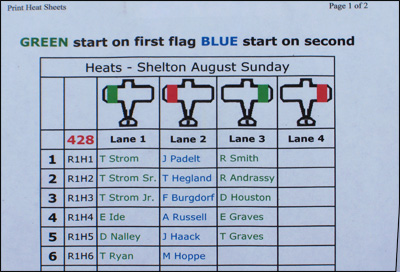
Pilots apply a decal according to their assigned starting-lane position for a heat:
- Lane-1, green decal on the low end of the wing,
- Lane-2, red decal on the low end of the wing,
- Lane-3, green decal on the high end of the wing, and
- Lane-4, red decal on the high end of the wing
If you visualize an aircraft in a steep, left-hand bank around a pylon (a counter-clockwise turn around a pylon), one end of the wing will be higher than the other. Aircraft in Lane 1 or 2 have a decal on the low end of the wing; aircraft in Lane 3 or 4 have a decal on the high end of the wing.
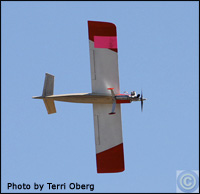
Course judges use the decals to identify each aircraft. For example, a "Cut Judge" might report a cut like this, "Pylon-3 cut on high red."
The color designations are also repeated on the signal board as described earlier: there are both low and high green and red colored rectangles painted on the board to designate the signal lights for each lane.
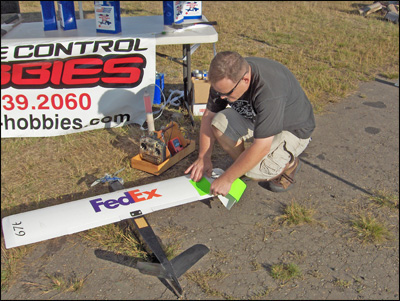
The Racing Begins
After the course workers occupy their work stations, the racing can begin. For safety, all stations are positioned at least 300 feet away from the race course. Both course workers and pilots are required to wear hard hats. The pilots, with their aircraft and callers, are driven both ways between the pit area and the starting line.
Among the many responsibilities of the starter is to have pilots perform a control check to insure that the RC system is functioning properly: the transmitter and receiver for each aircraft must be functioning correctly.

When the pilots/callers are ready, the starter starts the 60-second clock. After the clock starts, and because pilots do not want to start their engines too soon, they watch the clock closely until, in their experience, it's the right time to do so.


Pilots have 60 seconds to start their engines and signal their readiness to control the aircraft to the starter. After the engine has been started, the pilot typically moves away from the start line (towards pylon 2 and 3) and prepares to control the aircraft.
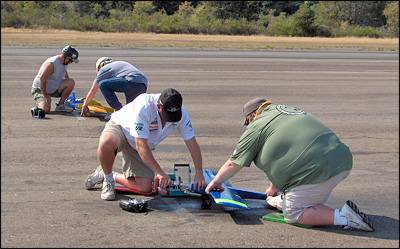

With the drop of the starter's flag, the callers launch the aircraft and race to the side of the pilots.

While the pilot controls the aircraft, the caller "calls" to the pilot when it's time to make a turn. Course judges watch the race carefully to make sure the planes round the pylons on the outside and do not turn a corner by cutting inside the pylon. A "cut" results in an extra lap; two "cuts" and the pilot is out of the race. Other course workers keep track of each lap completed by every aircraft and their time around the course.

As each aircraft completes the last lap, the starter drops his flag to indicate this to the pilot.

After all of the planes have completed the last lap of a heat, the starter records the heat results. Pilots receive points based on their finishing position: 4 points for first place, 3 for second, 2 for third, and 1 for fourth.
Back in the pit area, the heat winner must weigh his/her aircraft to insure that it is at or above the minimum allowable weight, as specified in the regulations.
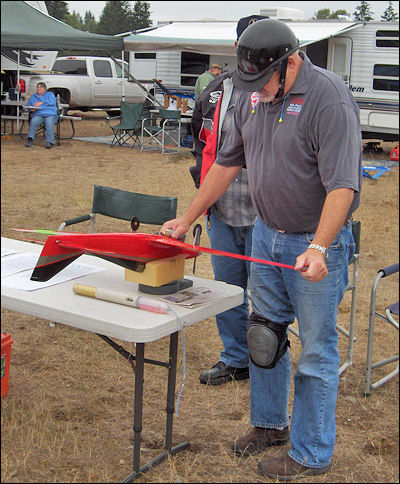
Resource Links
Academy of Model Aeronautics (AMA) –– More information about the Academy of Model Aeronautics (AMA) regulations for pylon racing.The National Miniature Pylon Racing Association –– The NMPRA is an organization of Pylon Racers whose mission is to promote, organize and standardize the hobby. This website is the home of the NMPRA but our members are spread across the Globe. Take a look around and get involved with the most exciting form of Radio Control.
Notes:
It is now 2020. It has been many years since there has been a pylon race at Sanderson Field. The pylon events were a thrill to watch and were great spectator events—particularly for me, a novice just getting started in RC. In 2008, many of the pilots were national contenders and Tom Strom Sr. was a national record holder. I, for one, am sad that they no longer take place at our field. Most of the photographs were taken with a camera that was really not up to the task. It would have been a pleasure to photograph the events with my more modern SLR camera.